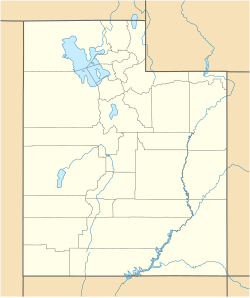Utah State Training School Amphitheater and Wall | |
 Utah State Training School Amphitheater, November 2015 | |
| Location | Roughly 845 East 700 North American Fork, Utah United States |
|---|---|
| Coordinates | 40°23′39″N111°46′31″W / 40.39417°N 111.77528°W |
| Area | less than one acre |
| Built | 1936 |
| Built by | Works Progress Administration |
| Architectural style | Rustic |
| MPS | Public Works Buildings TR |
| NRHP reference No. | 94001206 [1] |
| Added to NRHP | October 7, 1994 |
The Utah State Training School Amphitheater and Wall, is an amphitheater and boundary wall in northwest American Fork, Utah, United States, that is listed on the National Register of Historic Places. [1]
Contents




